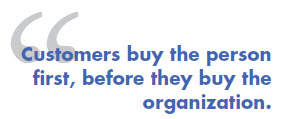Financial Post Best Managed
Denise Deveau, November 12, 2012
The expression “it’s business, not personal,” is slowly becoming extinct in the lexicon of Corporate Canada. In a media-savvy, 21st century workplace in which staff hear horror stories of excessive salaries, mismanagement, corruption et al, trust of business leaders is in rapid decline.
Recent research from Ipsos Reid and the Canadian Management Centre found that only 39 per cent of Canadians trust what their senior leaders say, and less than four in 10 feel senior leadership is doing a good job of communicating what is happening in their workplace.
This underwhelming level of trust comes as no surprise to branding experts. They contend that a leader’s success or failure in building trust and business success very much revolves around his or her personal brand. That’s not always an easy thing to manage in light of how much the world has changed.
They are more stressed and in a much more public setting than ever before. Now the (personal) performance of a CEO is being tied directly to the business.
Dianne Carmichael, CEO of Carmichael Worldwide Inc., an executive leadership specialist speaks from a position of considerable experience. Having served as CEO for a range of organizations, from consumer packaged goods and technology to wealth management and health care, she has seen significant shifts on the leadership branding front.
The availability and dissemination of information for one has been a major factor in eroding confidence, she explains. “In the past, leaders were seen to be all-knowing guardians of information and that has certainly changed, predominantly because of the Internet. With the democratization of information, one leader can no longer be that person who knows everything.”
 There was a time when a CEO could hide behind a corporate brand. Today that has changed as their celebrity is beginning to move to the forefront, notes Grant Goodwin, president of All Roads Inc., a personal online branding consultancy in Kingston.
There was a time when a CEO could hide behind a corporate brand. Today that has changed as their celebrity is beginning to move to the forefront, notes Grant Goodwin, president of All Roads Inc., a personal online branding consultancy in Kingston.
“We’re all more accessible and we expect others to be as well,” he says. “This is putting CEOs in a pretty bad spot in terms of personal branding. They are more stressed and in a much more public setting than ever before. Now the (personal) performance of a CEO is being tied directly to the business.”
CEOs also have to operate in a world where there is much greater demand for accountability and transparency. With the economic collapse and a raft of high profile corporate fiascoes, from oil spills to the implosion of mortgage backed securities, people are rightfully demanding that leaders be accountable and are seriously questioning what they represent.
It’s not enough to go through a branding exercise and define your value proposition. The key is having your words align with actions on all fronts. In other words, successful leaders are those who are the same person on and offline, and in their corporate and personal life.
 Any inconsistencies can wreak havoc, Ms. Carmichael notes. “You can’t be a chameleon; and you can’t derail your brand with demonstrations of poor judgment or ethics. Tiger Woods is a prime example of how poor judgment can torpedo your brand.”
Any inconsistencies can wreak havoc, Ms. Carmichael notes. “You can’t be a chameleon; and you can’t derail your brand with demonstrations of poor judgment or ethics. Tiger Woods is a prime example of how poor judgment can torpedo your brand.”
A physical presence is especially important for employees and customers, because as Ms. Carmichael states, “Customers buy the person first, before they buy the organization.”
For companies with far-reaching operations, much can be achieved through the strategic use of online technologies, from blogs to video messaging. When done right it allows them to demonstrate the human side of leadership, build trust and create an inclusive environment where employees can be a part of the company’s success.
We also try to involve as many employees as possible in strategic planning processes.
At Monarch Industries in Winnipeg, a manufacturer of hydraulic cylinders and iron castings, employee involvement has been integral to its long standing status as a Best Managed company. According to chief operating officer Roy Cook, the leadership brand that has carried them through the years is one of openness and respect for individuals, and a mutual desire to grow and build the company.
He says building trust really boils down to some important basics. “We just spend a lot of time communicating with management and employees,” he says. “We also try to involve as many employees as possible in strategic planning processes.”
Perhaps the most important branding lesson of all is the simplest to express, he adds. “We always try and do what we say we’ll do.”


Follow Dianne Carmichael